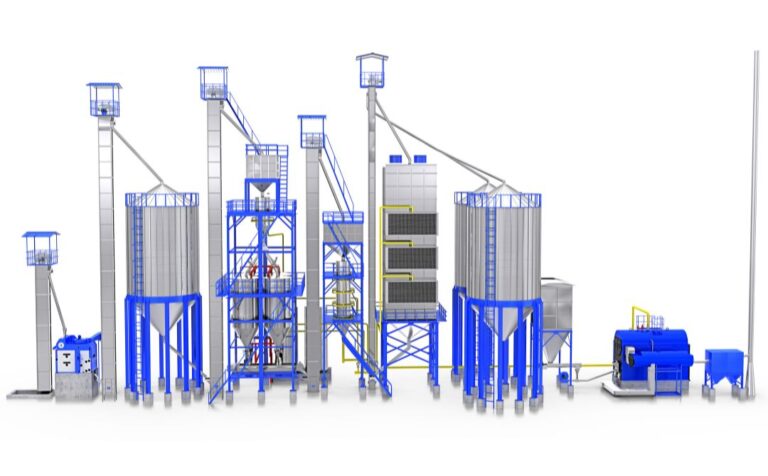Table of Contents
In India’s thriving rice industry, where over 120 million tonnes of paddy are processed annually, the choice of equipment can make or break a rice mill’s success. The paddy parboiling process is a critical step in enhancing the quality and nutritional value of paddy. Production of high-quality parboiled rice demands robust, reliable infrastructure to ensure efficiency and longevity.
At SKF Elixer, we lead the way with our stainless steel parboiling plants, crafted to deliver unmatched durability, hygiene, and performance for rice millers across the country. Our systems set a new standard for parboiling technology, tailored to meet the needs of India’s diverse rice processing landscape.
This blog explores why stainless steel parboiling plants outperform those made from mild steel or iron, highlighting their advantages and long-term value. Whether you’re a rice miller in Chhattisgarh, a cooperative leader in Andhra Pradesh, or an entrepreneur in Haryana, our insights will guide you toward smarter investments in paddy processing.
The Importance of Parboiling Process in Rice Production
Parboiling involves soaking, heating, and drying paddy to gelatinize starch and drive nutrients into the grain, producing parboiled rice with superior texture, nutrition, and market appeal. Read more about different types of paddy parboiling processes.
Inefficient parboiling equipment can lead to 3–5% grain losses (150–250 kilograms per 5 tonnes, worth ₹7,500–₹12,500 at ₹50 per kilogram) and inconsistent quality, reducing head rice recovery by 4–6%.
Stainless steel parboiling plants, like those from SKF Elixer, ensure precision, hygiene, and durability, achieving 95–97% head rice recovery and minimizing losses to below 1%. These plants align with Food Safety and Standards Authority of India (FSSAI) standards, boosting profitability for rice millers.
Why Stainless Steel Parboiling Plants?
Stainless steel, specifically food-grade stainless steel is a premium material known for its corrosion resistance, strength, and hygiene. Unlike mild steel or iron, which are prone to rust and wear, stainless steel ensures longevity and compliance with food safety norms.
SKF Elixer’s stainless steel plants are designed for capacities of 5–50 tonnes per day, offering rice millers a reliable solution for consistent parboiling.
Why Stainless Steel Outlasts Mild Steel or Iron Plants
Stainless steel offers distinct advantages over mild steel or iron:
- Corrosion Resistance: Stainless steel resists rust in humid conditions, unlike mild steel, which corrodes within 2–3 years, requiring repairs costing ₹1–2 lakh annually. SS304 withstands India’s monsoon climates, lasting 15–20 years.
- Hygiene: Food-grade stainless steel prevents bacterial growth, meeting FSSAI standards, while iron risks contamination, leading to 1–2% grain rejection (₹5,000–₹10,000 per 10 tonnes).
- Durability: Stainless steel withstands high temperatures and water exposure, unlike mild steel, which warps, causing downtime costing ₹50,000–₹1 lakh annually.
For a 20-tonne-per-day plant, stainless steel extends equipment life by 10–15 years, saving ₹10–15 lakh in replacement costs compared to mild steel.
Advantages of Stainless Steel Material
SKF Elixer’s stainless steel parboiling plants provide:
- Longevity: 15–20-year lifespan vs. 5–7 years for mild steel, saving ₹10–15 lakh in replacements for a 20-tonne-per-day plant.
- Hygiene Compliance: Food-grade SS304 ensures zero contamination, avoiding ₹5,000–₹10,000 per batch in rejected grain.
- Thermal Efficiency: Stainless steel retains heat better, reducing energy costs by 20–30% (₹1–2 lakh annually for a 10-tonne-per-day plant).
Low Maintenance: Corrosion resistance reduces cleaning and repair costs by ₹50,000–₹1 lakh annually compared to iron.
Cost vs. Value: Higher Upfront Cost but Long-Term Savings
Stainless steel parboiling plants have a higher upfront cost compared to mild steel. However, the long-term savings are significant:
- Reduced Maintenance: Stainless steel cuts maintenance costs by 50–60%, saving ₹50,000–₹1 lakh annually for a 20-tonne-per-day plant.
- Lower Downtime: Durable components ensure 98% uptime, saving ₹1–2 lakh annually in lost production compared to mild steel’s 80–85% uptime.
- Higher Yields: Improved head rice recovery (95–97%) adds ₹20,000–₹30,000 per 10 tonnes, totaling ₹2–3 crore annually for a 50-tonne-per-day mill.
- Market Value: Cleaner, hygienic rice fetches ₹5–10 more per kilogram, boosting revenue by ₹50 lakh–₹1 crore annually.
Operational Efficiency: Reduced Maintenance and Downtime
SKF Elixer’s stainless steel plants enhance efficiency:
- Corrosion-Resistant Design: Prevents scaling, reducing cleaning time by 50% and saving ₹30,000–₹50,000 annually in labor.
- IoT Monitoring: Real-time sensors optimize soaking and drying, cutting energy use by 20% (₹1–2 lakh annually for 10 tonnes per day).
- Automated Controls: Reduce labor by 60%, saving ₹50,000–₹1 lakh annually in man-hours for a 5-tonne-per-day plant.
SKF Elixer’s Stainless Steel Parboiling Solutions
Our plants cater to diverse needs:
- Small-Scale Mills: 5–10-tonne-per-day plants occupy 100–150 square meters, saving ₹50,000–₹1 lakh annually, ideal for cooperatives in Chhattisgarh.
- Large-Scale Mills: 20–50-tonne-per-day systems yield ₹2–3 crore annually in higher output for manufacturers in Andhra Pradesh.
- Custom Features: Food-grade stainless steel and IoT controls ensure hygiene and efficiency, with AMCs starting at ₹50,000 per year.
Why Choose SKF Elixer?
With over a decade of expertise, SKF Elixer delivers BIS-certified stainless steel parboiling plants tailored for India’s rice varieties. Our options, support, and AMCs ensure reliability, making us a trusted partner for rice millers.
Conclusion
Stainless steel parboiling plants offer unmatched durability, hygiene, and efficiency, outlasting mild steel or iron alternatives. SKF Elixer’s advanced systems deliver long-term savings and superior rice quality, empowering millers to thrive in India’s competitive rice industry.
Choose our solutions to elevate your operations.
Ready to invest in a superior parboiling plant? Contact SKF Elixer to explore our stainless steel solutions.
FAQs
-
1. Why do stainless steel parboiling plants outlast mild steel or iron plants?
Stainless steel resists corrosion, lasting 15–20 years vs. 5–7 years for mild steel, saving ₹10–15 lakh in replacements for a 20-tonne-per-day plant in humid climates like West Bengal.
-
2. What are the advantages of stainless steel material in parboiling plants?
Stainless steel ensures hygiene, reduces maintenance by 50–60% (₹50,000–₹1 lakh annually), improves thermal efficiency by 20–30% (₹1–2 lakh savings), and achieves 95–97% head rice recovery.
-
3. How does the cost vs. value of stainless steel plants benefit rice millers?
Higher upfront costs are offset by savings of ₹10–15 lakh in replacements, ₹50,000–₹1 lakh in maintenance, and ₹2–3 crore in yields annually for a 50-tonne-per-day plant.
-
4. How does stainless steel improve operational efficiency in parboiling?
Corrosion-resistant stainless steel reduces maintenance and downtime by 50%, saving ₹50,000–₹1 lakh annually, while IoT controls cut energy use by 20%, saving ₹1–2 lakh for 10 tonnes per day.
-
5. Why choose SKF Elixer’s stainless steel parboiling plants?
Our BIS-certified plants use food-grade stainless steel, ensuring hygiene and 15–20-year durability. With financing and AMCs (₹50,000/year), they save ₹2–3 crore annually in yields for millers in Andhra Pradesh.
-
6. What happens if a paddy parboiling plant is inefficient?
Inefficient parboiling equipment can lead to 3–5% grain losses (150–250 kilograms per 5 tonnes, worth ₹7,500–₹12,500 at ₹50 per kilogram) and inconsistent quality, reducing head rice recovery by 4–6%.
Good reads are meant to be shared









